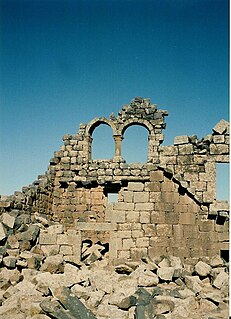
Parthenia was a Roman–Berber town in the former Roman province of Mauretania Sitifensis, the easternmost part of ancient Mauretania. It was located in what is now northern Algeria.

Cirta, also known by various other names in antiquity, was the ancient Berber and Roman settlement which later became Constantine, Algeria. Cirta was the capital city of the Berber kingdom of Numidia; its strategically important port city was Russicada. Although Numidia was a key ally of the ancient Roman Republic during the Punic Wars, Cirta was subject to Roman invasions during the 2nd and 1st centuries BC. Eventually it fell under Roman dominion during the time of Julius Caesar. Cirta was then repopulated with Roman colonists by Caesar and Augustus and was surrounded by a "confederation of free Roman cities" such as Tiddis, Cuicul, and Milevum. The city was destroyed in the beginning of the 4th century and was rebuilt by the Roman emperor Constantine the Great, who gave his name to the newly constructed city, Constantine. The Vandals damaged Cirta, but emperor Justinian I reconquered and improved the Roman city. It declined in importance after the Muslim invasions, but a small community continued at the site for several centuries. Its ruins are now an archaeological site.

Tiaret is a major city in central Algeria that gives its name to the wider farming region of Tiaret Province. Both the town and region lie south-west of the capital of Algiers in the western region of the Hautes Plaines, in the Tell Atlas, and about 150 km (93 mi) from the Mediterranean coast. It is served by Abdelhafid Boussouf Bou Chekif Airport.

Chlef is the capital of Chlef Province, Algeria. Located in the north of Algeria, 200 kilometres (120 mi) west of the capital, Algiers, it was founded in 1843, as Orléansville, on the ruins of Roman Castellum Tingitanum. In 1962, it was renamed al-Asnam, but since 1980 it has borne its present name, Chlef, which is derived from the name of the longest river in Algeria.

Zuccabar or Zucchabar was an ancient town in the Roman province of Mauretania Caesariensis. It is located in present-day Miliana, Algeria.

Umm el-Jimal, also known as Umm ej Jemāl, Umm al-Jimal or Umm idj-Djimal, is a village in Northern Jordan approximately 17 kilometers east of Mafraq. It is primarily notable for the substantial ruins of a Byzantine and early Islamic town which are clearly visible above the ground, as well as an older Roman village located to the southwest of the Byzantine ruins.

Saint Annemund, also known as Annemundus, Aunemundus, Ennemond and Chamond, was an archbishop of Lyon. Annemund was a councillor of Clovis II and a friend of Wilfrid of York. The year of his death is variously given as either 657 or 658.

Tiddis was a Roman city that depended on Cirta and a bishopric as Tiddi, which remains a Latin Catholic titular see.

Rapidum was a Roman settlement and fort located in Mauretania Caesariensis, nearly 100 km south of Icosium (Algiers).

Castellum Tingitii, also called Castellum Tingitanum, was a Roman colonia in Mauretania Caesariensis, and corresponds to present-day Chlef in Algeria.
Vagal or Vagalitanus was a Vandal and Roman era civitas (town) in Mauretania Caesariensis, Roman North Africa. The town has been tentatively identified with Sidi ben Thiour on the Mekerra River near its confluence with the Sly River.(36.073819n, 1.094881e) Nearby towns included Castellum Tingitanum and Catabum Castra (Djidioua). The mines at Malakoff were to the north-east of the town.

Borj Gourbata was an ancient Roman-Berber town in Qafşah, Tunisia. It is located at latitude 34°16'22.01", longitude 8°32'56" and 135 meters above sea level. The town is in the Sahel region of Tunisia, but at the junction of the Oued ech Cheria and the Oued el Jemel Wadis, making it an important oasis in the Sahara. It is situated between Gafsa and Chott el Jerid.

Castellum Minus was an ancient city located in the Roman province of Mauretania Caesariensis in today's northern Algeria. The ancient city is identified with ruins near Coléa, Algeria,(at 35.3877778° latitude and 0.1416667° longitude).

Gunugus or Gunugu was a Berber and Carthaginian town in northwest Africa in antiquity. It passed into Roman control during the Punic Wars and was the site of a colony of veteran soldiers. It survived the Vandals and Byzantines but was destroyed during the Muslim invasion of the area.
Castellum Ripae or Hadjar-Ouaghef is a locality and archeological site in Algeria, North Africa.
Castellum Tatroportus, also known as Tatroporto Castle or Latin: Dioctsis Castellotatro-Portensis, was a Roman–Berber civitas and former Roman Catholic diocese that flourished through the Vandal and Roman eras and into late antiquity. It was located in the province of Mauretania Caesariensis in Africa Proconsulare, though an exact location has not been identified.

Numida was an ancient Roman town in the Roman province of Mauretania Caesariensis. It was located in modern northern Algeria.

Castelvecchio is the ancient fortified village of Castel Goffredo, in the province of Mantua Lombardy region in Italy, surrounded by walls and a moat. The boundaries currently correspond to the garden of the Palazzo Gonzaga-Acerbi to the north, to vicolo Remoto and vicolo Cannone to the east, to Piazza Mazzini to the south and to piazzetta Castelvecchio and vicolo Castelvecchio to the west.
Papirion, also called Papiriou Castellum and Cherreos Eryma, was a town of ancient Cilicia, inhabited in Byzantine times.












